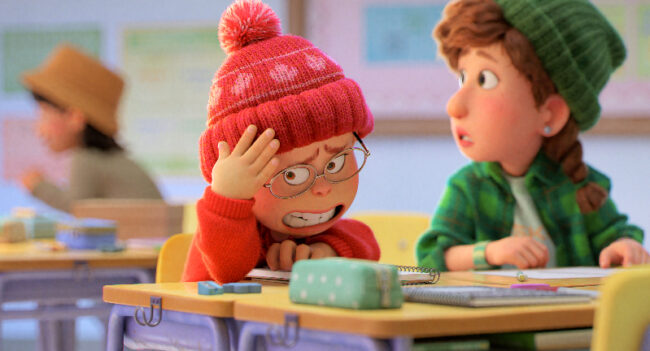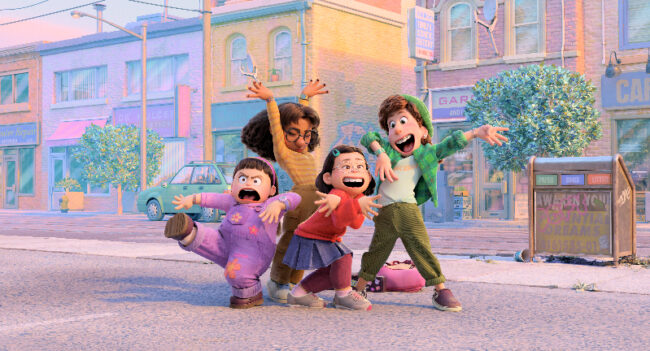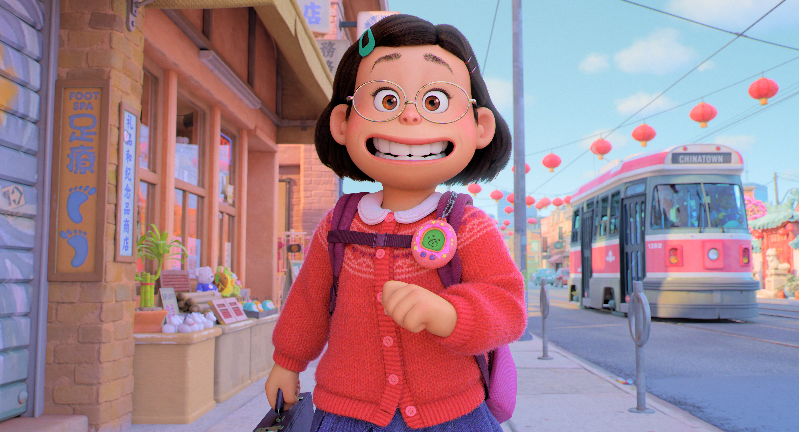“Turning Red,” directed and co-written by the incomparable Domee Shi, wants to let its audience know that growing up can be messy. Really messy. It’s a moment in time full of changes out of our control. These changes are painful, distressing, and smelly. And while it can be very chaotic and confusing, the film lets us know that everything will be fine at the end of it all. That kind of reassurance is hard to come by, especially for animated films. So for “Turning Red” to talk so openly and honestly about puberty, self-discovery, and the changes that occur to a parent and child relationship is refreshing.

Shi leaned into her childhood experiences growing up in Toronto, Canada, and turned it into a full-length animated feature – that sadly was relegated to a Disney+ exclusive release. In many ways, the film subverts what female friendships are and how tiger moms are portrayed in film. The two have been stereotypically shown as catty, one-dimensional, and flat-out mean for far too long. But “Turning Red” is an opportunity to debunk all of that and display them in a positive light. For we see how Meiling (Rosalie Chaing) justifies her reverence to her strict and overprotective mother, Ming (Sandra Oh).
Meiling knows that her parents brought her into this world, gave her a home, and fed her with an epic amount of food. As such, the least she can do is return the favor by honoring them, respecting their wishes, and handing them perfect grades. But, of course, it’s not all bad, as we see how Meiling and Ming bond over a fondness of cleaning the local temple. And though our confident and dorky protagonist says she makes her own moves, she owes a lot of it to her mother, who may or may not see that she’s putting too much pressure on her daughter. But it’s not all bad. It’s a relationship based on Ming wanting what’s best for her child while also still connecting with her on a friendly level. The two clearly love each other, as noted by how they clean their temple together in unison or watch Chinese soap dramas – which happens to use Cantonese subtitles.
Meiling is a 13-year-old Chinese Canadian teenager navigating adolescence while balancing her mother’s approval and being herself with her friends. Not an easy task. Especially when she wakes up one morning as a giant red panda. Unsure of what to make of this new form, Meiling discovers that she risks releasing the panda if she exhibits any strong emotion. Worried about what her friends will think of her, Meiling tries to keep calm and waits an entire month until the next red moon to participate in a ritual that would seal the red panda.

Shi tells this story about the changes that occur during puberty and the changes that occur to the relationship between a parent and child through the lens of her experience. As such, it brings a relatable East-meets-West element to the film that firs-generational persons, like myself, can connect with. Among these scenes is how the film portrays Meiling’s journey of finding her identity and the bonds that she shares with friends, who are meant to reflect the multiculturalism of Toronto, Canada.
Meiling lives quite a sheltered life. “Turning Red” doesn’t show us much of her life outside of school, her temple, and her adjacent home within the first 20 minutes or so. As such, we get to see how she tries so hard to spend time with her friends like the ever so supportive Miriam (Ava Morse), the gothy but warm Priya (Maitreyi Ramakrishnan), and the fiercest ally Abby (Hyein Park). Together, they make a formidable group of friends who live by the “ride or die” code and won’t put up with any classmate who annoys them, like Trevor.

But Meiling’s efforts to be a part of the group are also cut short because of her responsibilities back home. Responsibilities that hold her back from being the person she’s destined to be. Of course, she justifies leaving her friends by saying cleaning the temple is fun, but what she doesn’t realize is how that, turning in perfect grades, and tirelessly working to keep her mother’s approval is doing more harm than good. And since Ming holds her daughter in such high regard, she also cannot see how this negatively affects her upbringing.
This brings us to the red panda transformations. Because for all of the film’s efforts to celebrate these female friendships as they are and not what they are portrayed to be and be a love story to mothers and daughters and Shi’s hometown, “Turning Red” is very much about Meiling’s journey of self-discovery. She and her ancestors have a shared history with the pandas, which were initially meant to protect their family from those who would want to harm them. So what was meant to be a blessing ultimately became an inconvenience when the family traveled to the new world.
But for all of Ming, her mother, and Meiling’s aunties’ efforts to dissuade Meiling from unleashing the panda and move forward with the ritual, our protagonist soon realizes that she may want to break tradition by keeping the panda. It becomes one of the first steps she takes on her journey to find her identity on her own. But, of course, then there are other mounting pressures like Meiling’s favorite boy band, 4*Town, coming to Toronto for a concert. It’s a once-in-a-lifetime chance for her and her friends to become women, at least according to them. Because we all know what that’s like to experience a concert of such magnitude that would define who we are.
That is what makes “Turning Red” one of the best coming-of-age films in recent memory. It strikes that balance between engaging its audience with a grounded story and making it wholly entertaining with its use of magic. The red panda transformation moments are fun. Watching Miriam, Priya, and Abby stick by Meiling as she is emotionally reeling during a great deal of confusion highlights the power of friendship. It also shows us how these female friendships should be portrayed. And it leaves a more significant impact when the crew put their heads together and hustle the panda to make the money needed to buy the expensive tickets to go to the concert. But the spirit of their friendship is captured when the four have a video recording of them having fun drinking sodas, using their entrepreneurial skills, and all-around goof off – and all of that with a 4*town song playing in the background.
Of course, there are other complications, some of which conveniently appear but ultimately work for the film, that stand in the way of Meiling accomplishing her goal. This includes Tyler, whose dislike for Meiling is more of a general and childish misunderstanding or a kid just being a kid. In addition, Meiling’s stringent grandmother (Wai Ching Ho), also a source of conflict, notices that Meiling has been lying to her mother and warns her about what could happen if she continues to panda out. But Meiling’s grandmother’s concern comes from a place that means well but is also a little bit out of touch.
Meiling’s journey through adolescence is an emotionally-charged one, much like everyone who has experienced puberty. Shi’s decision to utilize anime styles and influences could be the best way to express the characters’ feelings. Watching the starry-eyed gushing as Meiling and her friends lose it over the sight of boys or 4*Town is reminiscent of animes like Sailor Moon, which shares much of its themes of friendship and visual styles with the film. Meanwhile, other explosive action pieces stem from animes like “Dragon Ball Z.”
And “Turning Red” is as much a film about friendship and mothers and daughters as it is a love letter to Shi’s hometown of Toronto. Within each frame of the film lies some nods to the great northern country. The CN Tower and the Skydome represent some of the filmmakers’ more obvious choices to ensure the Canadian province is well-represented. But it’s also within the script and visual language. Slang words like loonie for money or a tuque for a beanie are a part of the dialogue. And there are some other fun nods that some Canadians or eagle-eyed people may be able to pick up on.
There’s also a heartfelt emotional element, as “Turning Red” talks honestly and openly about puberty. I may not speak to the characters’ experiences directly, but the film addresses the subject matter with such intensity that it’s hard not to cringe. Sure, there are moments when the film has to speak in code when Ming thinks Meiling’s shock at what she’s become is about her period. But that is usually followed by a grounded element when Ming tells her that she’s prepped with pads, hot water bags, etc.
“Turning Red” also finds its honesty in how the person changes during this time. Meiling, who may have seemed disinterested in local boys at first, suddenly finds herself drawing them embracing her intimately. She has no idea what’s come over her, but she also can’t help stop drawing and fawning over each piece. And the idea that she disappointed her mother, who is shocked to find out that she drew these things and thought that she was touched that way, confirms how much of the film is about self-discovery. Because now, she likes boys, listens to loud music, and resorts to lying to her mother to go to the concert. This is contrary to everything that Ming believes she’s taught her daughter and the beliefs that she holds.
But within Ming trying to prove a point, we also see how much “Turning Red” is a story about generational traumas. The way that she worries for her daughter when she first changes into a giant red panda or talks to her husband Jin about not wanting this for Meiling. Again, this speaks to the idea of generations and East meets West. So her going against her mother’s wishes leans into Meilin’s self-discovery. But Meiling also realizes that she still can revere her mother despite her newfound rebellious nature.
For what it’s worth, “Turning Red” may be small when compared to the likes of “Soul,” but it has plenty of humor and heart like “Luca.” And as one of the three original titles, it’s a bit sad to see Shi’s directorial debut be relegated to a Disney+ exclusive – but there will be special showings at Los Angeles’ El Capitan. Still, Pixar’s coming-of-age tale is heartfelt and funny, with the kind of emotional nuance that lets people feel seen authentically. It subverts those toxic tropes of female friendships and tiger moms. But above all, “Turning Red” tells us a story about growing pains through the lens of a Chinese Canadian girl, who by all accounts, honors her parents, recognizes where her moves come from, but still wants to be her own person and comes to terms with the fact that these changes are natural and very necessary on her journey of self-discovery.











